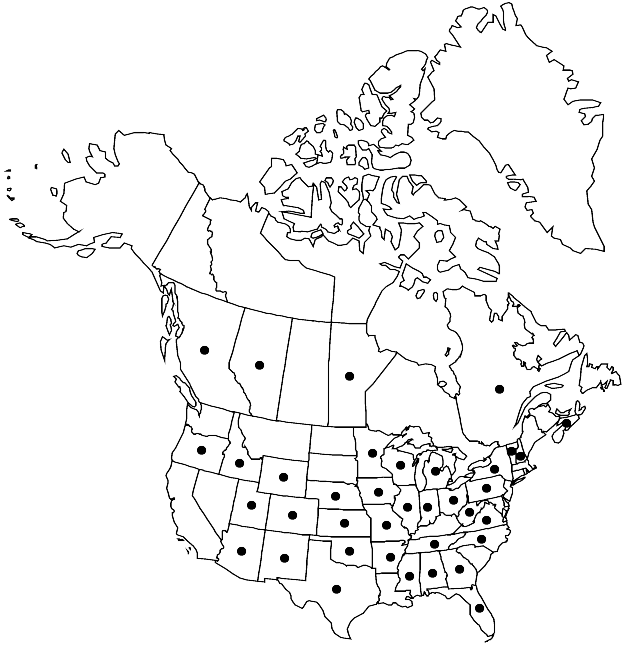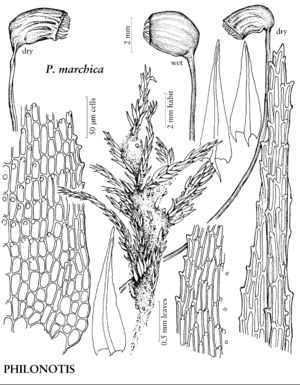Difference between revisions of "Philonotis marchica"
Bryol. Univ. 2: 23. 1827.
FNA>Volume Importer |
imported>Volume Importer |
||
| (6 intermediate revisions by 2 users not shown) | |||
| Line 9: | Line 9: | ||
|special_status={{Treatment/ID/Special_status | |special_status={{Treatment/ID/Special_status | ||
|code=F | |code=F | ||
| − | |label= | + | |label=Illustrated |
}} | }} | ||
| − | |basionyms={{Treatment/ID/ | + | |basionyms={{Treatment/ID/Basionym |
|name=Mnium marchicum | |name=Mnium marchicum | ||
|authority=Hedwig | |authority=Hedwig | ||
| + | |rank=species | ||
| + | |publication_title=Sp. Musc. Frond., | ||
| + | |publication_place=196. 1801 | ||
}} | }} | ||
|synonyms={{Treatment/ID/Synonym | |synonyms={{Treatment/ID/Synonym | ||
|name=Philonotis muehlenbergii | |name=Philonotis muehlenbergii | ||
|authority=(Schwägrichen) Bridel | |authority=(Schwägrichen) Bridel | ||
| + | |rank=species | ||
}} | }} | ||
|hierarchy=Bartramiaceae;Philonotis;Philonotis marchica | |hierarchy=Bartramiaceae;Philonotis;Philonotis marchica | ||
| Line 33: | Line 37: | ||
|elevation=low to high elevations (30-3000 m) | |elevation=low to high elevations (30-3000 m) | ||
|distribution=Alta.;B.C.;Man.;N.S.;Que.;Ala.;Ariz.;Ark.;Colo.;Fla.;Ga.;Idaho;Ill.;Ind.;Iowa;Kans.;Mich.;Minn.;Miss.;Mo.;Nebr.;N.H.;N.Mex.;N.Y.;N.C.;Ohio;Okla.;Oreg.;Pa.;Tenn.;Tex.;Utah;Vt.;Va.;W.Va.;Wis.;Wyo.;Mexico;Central America;n South America (Colombia);Europe;Asia;n Africa;Atlantic Islands (Macaronesia). | |distribution=Alta.;B.C.;Man.;N.S.;Que.;Ala.;Ariz.;Ark.;Colo.;Fla.;Ga.;Idaho;Ill.;Ind.;Iowa;Kans.;Mich.;Minn.;Miss.;Mo.;Nebr.;N.H.;N.Mex.;N.Y.;N.C.;Ohio;Okla.;Oreg.;Pa.;Tenn.;Tex.;Utah;Vt.;Va.;W.Va.;Wis.;Wyo.;Mexico;Central America;n South America (Colombia);Europe;Asia;n Africa;Atlantic Islands (Macaronesia). | ||
| − | |discussion=<p>Philonotis marchica is recognized by its usually plane, singly serrulate leaf margins and laminal cells bearing rounded prorulae near the distal ends. Philonotis capillaris, a species mainly of Pacific coastal habitats, shares with P. marchica the singly serrulate leaf margin. However, P. capillaris, in contrast to P. marchica, has a more or less decumbent, flaccid habit, more distant, widespread leaves, shorter and broader distal laminal cells and obscure prorulae in the basal half of the leaf.</p> | + | |discussion=<p><i>Philonotis marchica</i> is recognized by its usually plane, singly serrulate leaf margins and laminal cells bearing rounded prorulae near the distal ends. <i>Philonotis capillaris</i>, a species mainly of Pacific coastal habitats, shares with <i>P. marchica</i> the singly serrulate leaf margin. However, <i>P. capillaris</i>, in contrast to <i>P. marchica</i>, has a more or less decumbent, flaccid habit, more distant, widespread leaves, shorter and broader distal laminal cells and obscure prorulae in the basal half of the leaf.</p> |
|tables= | |tables= | ||
|references= | |references= | ||
| Line 42: | Line 46: | ||
-->{{#Taxon: | -->{{#Taxon: | ||
name=Philonotis marchica | name=Philonotis marchica | ||
| − | |||
|authority=(Hedwig) Bridel | |authority=(Hedwig) Bridel | ||
|rank=species | |rank=species | ||
| Line 56: | Line 59: | ||
|publication title=Bryol. Univ. | |publication title=Bryol. Univ. | ||
|publication year=1827 | |publication year=1827 | ||
| − | |special status= | + | |special status=Illustrated |
| − | |source xml=https:// | + | |source xml=https://bitbucket.org/aafc-mbb/fna-data-curation/src/2e0870ddd59836b60bcf96646a41e87ea5a5943a/coarse_grained_fna_xml/V28/V28_170.xml |
|genus=Philonotis | |genus=Philonotis | ||
|species=Philonotis marchica | |species=Philonotis marchica | ||
Latest revision as of 21:34, 5 November 2020
Plants small, in loose to dense tufts, yellowish or bright green, brown proximally. Stems 1–6 cm, erect, simple or 2-fid, tomentose proximally. Leaves erect-spreading when dry, somewhat divergent when moist, triangular- to slightly ovate-lanceolate, 1–2.3 mm; margins plane or sometimes narrowly revolute, serrulate nearly to base, teeth single; apex acuminate; costa percurrent to long-excurrent, abaxial surface weakly papillose; laminal cells rectangular, less than 9:1, prorulose, prorulae rounded, near distal ends or sometimes both ends on abaxial side; basal cells oblong, 18–45 × 6–15 µm; distal cells linear oblong, 20–30 × 4–8 µm. Specialized asexual reproduction by propagula sometimes borne in leaf axils. Sexual condition dioicous; perigonia discoid. Seta 1.5–4 cm, flexuose. Capsule 1–2.5 mm. Spores spheric, 20–30 µm.
Phenology: Capsules mature Mar–Sep.
Habitat: Rock, soil, wet places, roadsides, springs
Elevation: low to high elevations (30-3000 m)
Distribution

Alta., B.C., Man., N.S., Que., Ala., Ariz., Ark., Colo., Fla., Ga., Idaho, Ill., Ind., Iowa, Kans., Mich., Minn., Miss., Mo., Nebr., N.H., N.Mex., N.Y., N.C., Ohio, Okla., Oreg., Pa., Tenn., Tex., Utah, Vt., Va., W.Va., Wis., Wyo., Mexico, Central America, n South America (Colombia), Europe, Asia, n Africa, Atlantic Islands (Macaronesia).
Discussion
Philonotis marchica is recognized by its usually plane, singly serrulate leaf margins and laminal cells bearing rounded prorulae near the distal ends. Philonotis capillaris, a species mainly of Pacific coastal habitats, shares with P. marchica the singly serrulate leaf margin. However, P. capillaris, in contrast to P. marchica, has a more or less decumbent, flaccid habit, more distant, widespread leaves, shorter and broader distal laminal cells and obscure prorulae in the basal half of the leaf.
Selected References
None.
